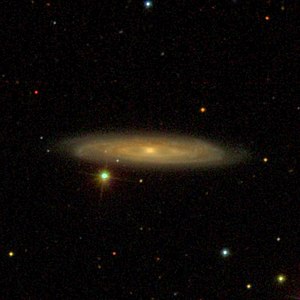NGC 4843
| Galaxy NGC 4843 |
|
|---|---|

|
|
| SDSS recording | |
| AladinLite | |
| Constellation | Virgin |
|
Position equinox : J2000.0 , epoch : J2000.0 |
|
| Right ascension | 12 h 58 m 00.8 s |
| declination | -03 ° 37 ′ 16 ″ |
| Appearance | |
| Morphological type | SA (r) 0 / a? |
| Brightness (visual) | 13.1 mag |
| Brightness (B-band) | 14.0 mag |
| Angular expansion | 2.1 ′ × 0.5 ′ |
| Position angle | 87 ° |
| Surface brightness | 13.0 mag / arcmin² |
| Physical data | |
| Redshift | 0.016398 ± 0.000027 |
| Radial velocity | 4916 ± 8 km / s |
|
Stroke distance v rad / H 0 |
(216 ± 15) · 10 6 ly (66.1 ± 4.6) Mpc |
| history | |
| discovery | Wilhelm Herschel |
| Discovery date | March 11, 1787 |
| Catalog names | |
| NGC 4843 • PGC 44388 • CGCG 015-048 • MCG + 00-33-024 • IRAS F12554-0320 • 2MASX J12580082-0337161 • GC 3332 • H III 613 • h 1492 • | |
NGC 4843 is a 13.1 mag bright lens-shaped galaxy of the Hubble-type S0 / a in the constellation Virgo at the ecliptic . It is estimated to be 216 million light years from the Milky Way and about 135,000 light years in diameter .
The object was discovered on March 11, 1787 by Wilhelm Herschel with an 18.7-inch reflecting telescope, who described it as “vF, E, easily resolvable”.
